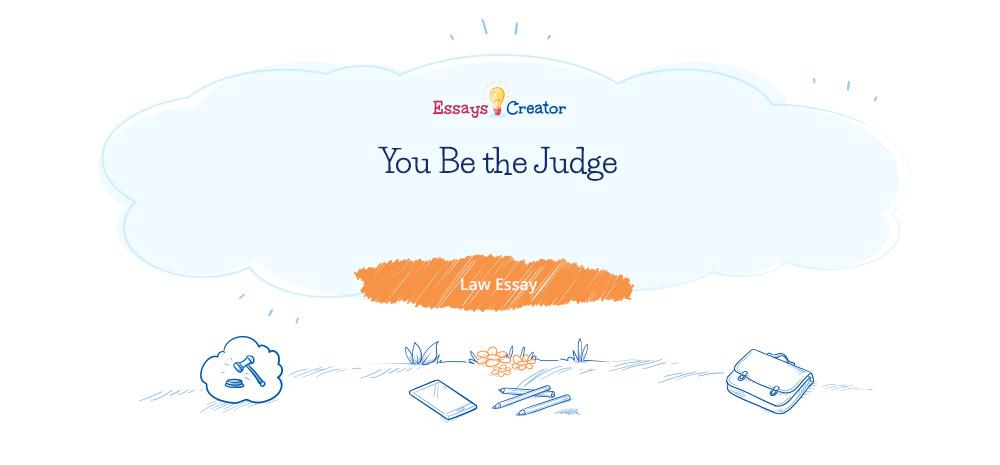
You Be the Judge Free Essay
The scenario is as follows: John is having a drink at a local bar and starts talking with David
After a few hours, John takes a dollar bill out of his pocket, rips it in half, and gives the other half to David. John does this whenever he meets someone that he considers his friend. After John leaves the bar, he starts walking down the street to his home when he is attacked from behind by two men. Officer Smith, a rookie officer on his second day on the job, is parked in a nearby parking lot and sees the attack. He chases the attackers down the street where they run into a house. Once in the house the men turn off all of the lights and lock the door. Officer Smith knocks on the door and a man tells him to go away without opening the door. Officer Smith says, “I saw you attack that man in the street. Come out here with your hands up.”
The man in the house says that he is alone and has not left the house all day. Officer Smith tries to talk the attackers out of the house for 30 minutes, but they do not come out. Several of Officer Smith’s fellow officers had gone to a judge, obtained a search warrant, and were on their way to the house. Officer Smith, tired of waiting, decides to kick down the door, arrests the two men inside, and finds a pocket full of half-torn dollar bills. The two men are taken to the police station and confess to attacking and robbing John.
Order your Law Essay help today!
Acting as a Defense Attorney, the following can be undertaken to suppress evidence before trial
According to the scenario, the police officer broke into the house without a search warrant, arrested, and searched the defendants without the appropriate justification for his actions. The main reason to believe so is the fact that he did not see the men attacking the victim so Officer Smith would not be able to recognize them (NPC, 2007). Then, the lights were turned off and there was no opportunity to see if there are people that can be potentially recognized as attackers (body shape, height, clothes, etc.).
The search was unauthorized by the appropriate warrant, so torn bills cannot be recognized as evidence: it is not possible to prove that these bills had the victim. The defendants have such a hobby – to tear bills apart and carry them with them. According to the 4th Amendment, Officer Smith had no right to search and arrest the defendants in this case. The 4th Amendment is “The right of the people to be secure in their persons, houses, papers, and effects against unreasonable searches and seizures shall not be violated, and no Warrants shall issue, but upon probable cause, supported by Oath or affirmation and particularly describing the place to be searched and the persons or things to be seized.” (PoliceCrimes.com, 2013).
It is necessary to eliminate the evidence from the evidence list according to the exclusionary rule and suppress charges. According to the exclusionary rule (NPC, 2007), the evidence was obtained by the unlawful search so it cannot be used for criminal prosecution. Since bills are the main supporting evidence, no evidence can be used to prosecute the defendants. They did nothing wrong and were searched and arrested illegally. They should be let go immediately (Garland, 2011; NPC, 2007).
Acting as Prosecutor, the following can be done to allow the judge to consider all the evidence and case scenarios and make the right decision
Officer Smith had no legal right to break into the house and arrest the defendants. However, it is also clear that he did not have a warrant in his hands, while the actual warrant was obtained and the actions of Officer Smith had the legal background (and legal warrant) to proceed.
More to say, there is one substantial exception from the exclusionary rule that can be used to justify the actions of Officer Smith. According to LII (2013), “If officers had reasonable, good faith belief that they were acting according to legal authority, such as by relying on a search warrant that is later found to have been legally defective, the illegally seized evidence is admissible.” It means that all actions of Officer Smith were legally justified (yet a bit prematurely) so the evidence must be recognized as admissible and the defendants prosecuted according to the law.
Acting as the Judge, the following reasoning can be applied to the current situation. The evidence was obtained without having a legal order “on-site”. Officer Smith cannot recognize defendants as those who attacked the victim for 100% (Garland, 2011; NPC, 2007). The defendants were in the house legally. It is also possible that torn bills are not from the pockets of the victim.
However, considering the confession of the defendants and exceptions from the exclusionary rule, the evidence should be considered legal. In the light of the provided evidence and the described situation, the following should be done further: it is utterly important to find the connection between the bills’ parts found at the crime scene and given by the victim to the potential friends (Garland, 2011; NPC, 2007). It is vital to prove the fact that bills seized from defendants are from the victim’s pockets. Therefore, it is necessary to find the man the victim had talked to in the bar and question him.

